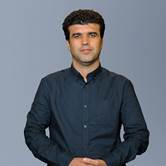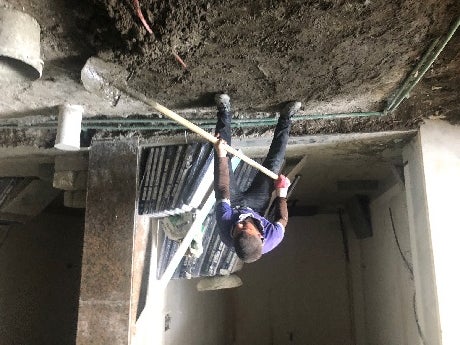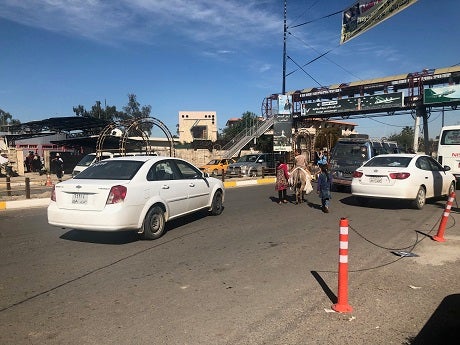MOSUL, Iraq – Abdullah Zaker wakes up every day at 4am to make it to work on time. He must cross one of Mosul’s dilapidated bridges over the Tigris River to reach the Old City where he works in construction, earning just 15,000 dinars ($12.50) per day.
“The main problem is lack of social insurance,” Abdullah told Rudaw English on a building site near the city’s famous university on the eve of International Workers’ Day.
None of the two dozen men laboring at the site are covered by government or private insurance. They can’t afford to be picky, however. Any work is better than none.
“There is hardly any reconstruction work for people like me,” Abdullah said, his face plastered with dust. “Many people would be happy to even find this kind of work.”
He is one of tens of thousands of West Mosul residents trying to rebuild their lives after savage fighting devastated their city in early 2017. For them, the battle for survival truly began when the fighting stopped.
Two million Mosul residents endured three years of Islamic State (ISIS) rule, which came to a shattering end in mid-2017 when eight months of ground and air assault finally dislodged the jihadists. Militants who survived the barrage melted into the population.
Abdullah and his co-workers agree security has improved since the new Iraqi government was formed late last year, but complain Baghdad is not doing enough to help get the northern city back on its feet.
Driving through Mosul, the scars of war are evident everywhere. Minarets and church towers are peppered with bullet holes, while families eke out an existence in semi destroyed houses.
“The provision of services is zero,” said Mohammad, a father of three. His main concerns are official corruption and the lack of basic utilities.
The 31-year-old has worked in construction for eight years, even continuing his trade under ISIS rule.
“It is true that the electricity is good now but that is only because of the good weather conditions,” he said.
Several bridges over the Tigris River, which bisects the city, were badly damaged during the war. Recent flooding has further disrupted commuters and the movement of goods and materials.
“Repairing the bridges, employment, reconstruction, and the provision of services,” Mohammad said, when asked what his main concerns are for the city.
Reconstruction began quickly after Mosul was retaken – beginning with the collection of explosives and bodies trapped under the rubble.
However, almost two years later, thousands of people are still living in damaged buildings. Impoverished children meanwhile are unable to attend school.
Thousands more from Nineveh and other war-battered provinces still live in internally displaced persons (IDP) camps across the Kurdistan Region with little prospect of return.
Iraqi officials say they need more than $80 billion to rebuild the country. Pledges for around $30 billion were made at the Kuwait International Conference for Reconstruction of Iraq in February 2018, but just a fraction of this has been delivered.
There are still close to 1.7 million Iraqis displaced as a result of fighting and instability since 2003.
In a recent meeting between Kurdistan Region Prime Minister Nechirvan Barzani and Iraqi parliamentary speaker Mohammed al-Halbousi, the parties “emphasized the significance of assistance from the Baghdad government and the international community for displaced Iraqis so they can return home”.
Key to this is the reconstruction of areas damaged by war, they said.
With the afternoon wearing on, Abdullah pulls on his gloves and resumes work mixing cement. How will he be spending International Workers’ Day on May 1?
“I’ll be working,” Abdullah said.
“The main problem is lack of social insurance,” Abdullah told Rudaw English on a building site near the city’s famous university on the eve of International Workers’ Day.
None of the two dozen men laboring at the site are covered by government or private insurance. They can’t afford to be picky, however. Any work is better than none.
“There is hardly any reconstruction work for people like me,” Abdullah said, his face plastered with dust. “Many people would be happy to even find this kind of work.”
He is one of tens of thousands of West Mosul residents trying to rebuild their lives after savage fighting devastated their city in early 2017. For them, the battle for survival truly began when the fighting stopped.
Abdullah Zaker mixes cement at a building site near Mosul University, Old City of Mosul, April 30, 2019. Photo: Fazel Hawramy / Rudaw
Two million Mosul residents endured three years of Islamic State (ISIS) rule, which came to a shattering end in mid-2017 when eight months of ground and air assault finally dislodged the jihadists. Militants who survived the barrage melted into the population.
Abdullah and his co-workers agree security has improved since the new Iraqi government was formed late last year, but complain Baghdad is not doing enough to help get the northern city back on its feet.
Driving through Mosul, the scars of war are evident everywhere. Minarets and church towers are peppered with bullet holes, while families eke out an existence in semi destroyed houses.
“The provision of services is zero,” said Mohammad, a father of three. His main concerns are official corruption and the lack of basic utilities.
The 31-year-old has worked in construction for eight years, even continuing his trade under ISIS rule.
“It is true that the electricity is good now but that is only because of the good weather conditions,” he said.
Several bridges over the Tigris River, which bisects the city, were badly damaged during the war. Recent flooding has further disrupted commuters and the movement of goods and materials.
A street scene in downtown Mosul, northern Iraq, on April 30, 2019. Photo: Fazel Hawramy / Rudaw
“Repairing the bridges, employment, reconstruction, and the provision of services,” Mohammad said, when asked what his main concerns are for the city.
Reconstruction began quickly after Mosul was retaken – beginning with the collection of explosives and bodies trapped under the rubble.
However, almost two years later, thousands of people are still living in damaged buildings. Impoverished children meanwhile are unable to attend school.
Thousands more from Nineveh and other war-battered provinces still live in internally displaced persons (IDP) camps across the Kurdistan Region with little prospect of return.
Iraqi officials say they need more than $80 billion to rebuild the country. Pledges for around $30 billion were made at the Kuwait International Conference for Reconstruction of Iraq in February 2018, but just a fraction of this has been delivered.
There are still close to 1.7 million Iraqis displaced as a result of fighting and instability since 2003.
In a recent meeting between Kurdistan Region Prime Minister Nechirvan Barzani and Iraqi parliamentary speaker Mohammed al-Halbousi, the parties “emphasized the significance of assistance from the Baghdad government and the international community for displaced Iraqis so they can return home”.
Key to this is the reconstruction of areas damaged by war, they said.
With the afternoon wearing on, Abdullah pulls on his gloves and resumes work mixing cement. How will he be spending International Workers’ Day on May 1?
“I’ll be working,” Abdullah said.






Comments
Rudaw moderates all comments submitted on our website. We welcome comments which are relevant to the article and encourage further discussion about the issues that matter to you. We also welcome constructive criticism about Rudaw.
To be approved for publication, however, your comments must meet our community guidelines.
We will not tolerate the following: profanity, threats, personal attacks, vulgarity, abuse (such as sexism, racism, homophobia or xenophobia), or commercial or personal promotion.
Comments that do not meet our guidelines will be rejected. Comments are not edited – they are either approved or rejected.
Post a comment